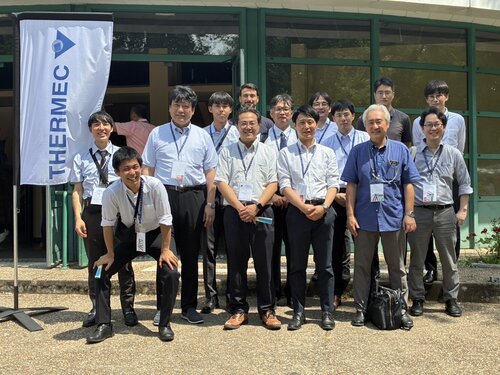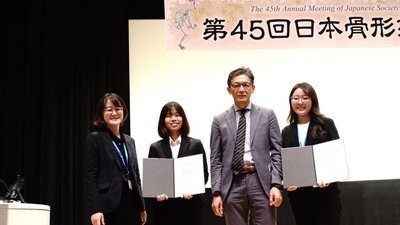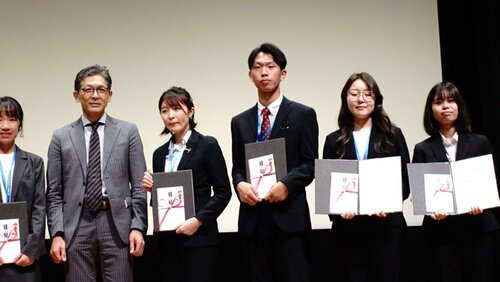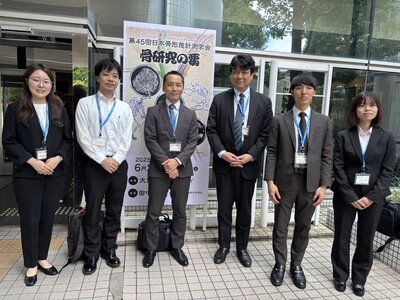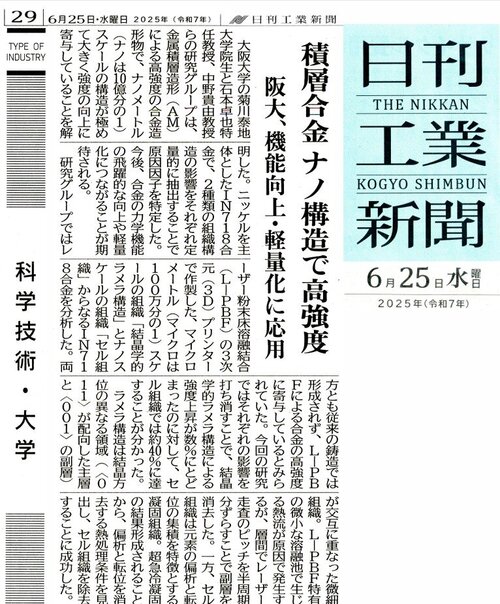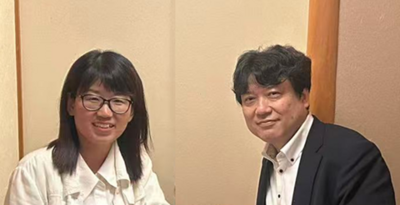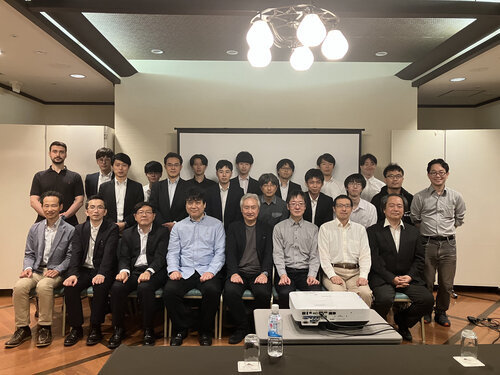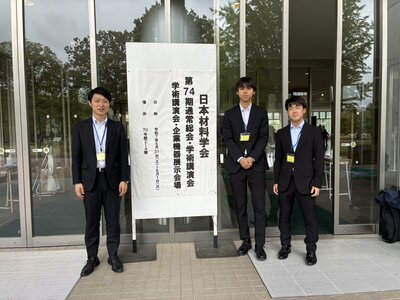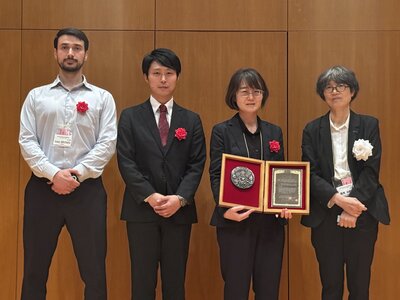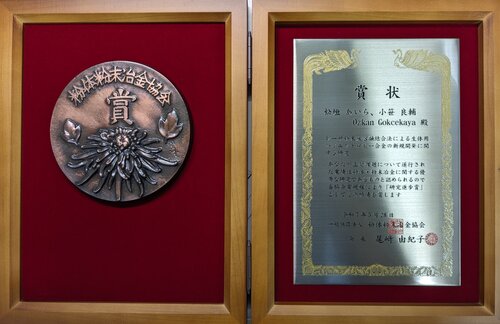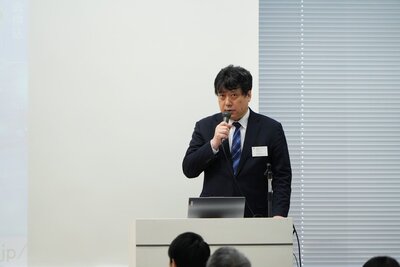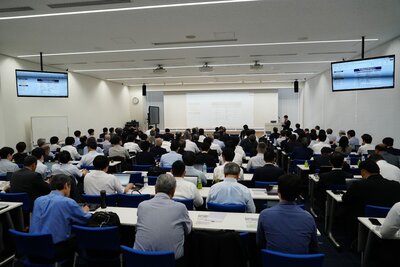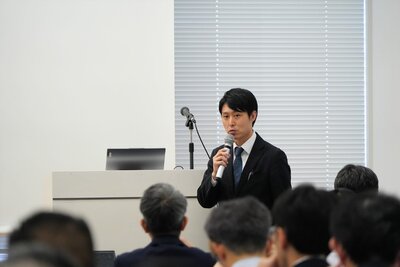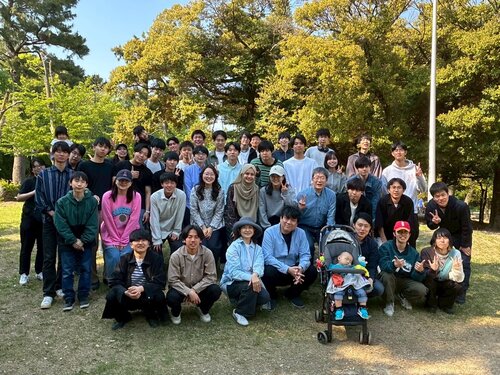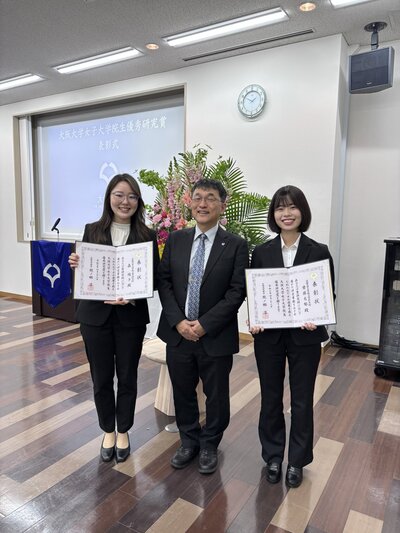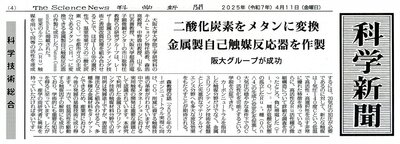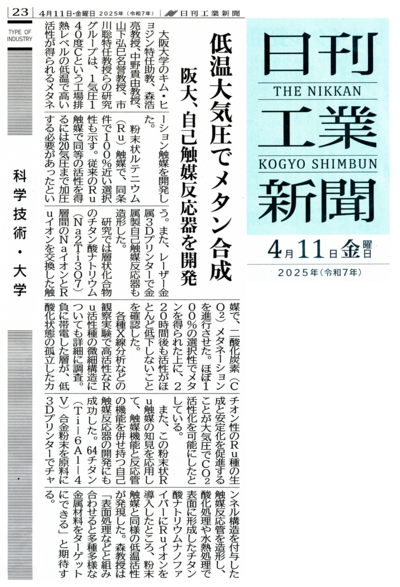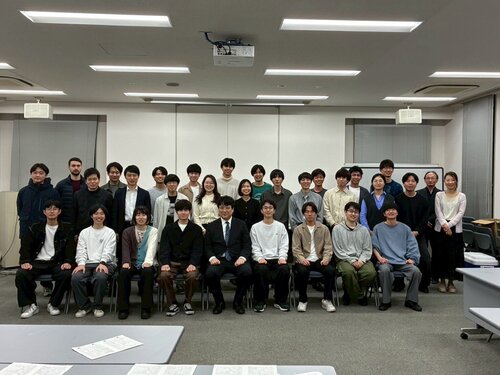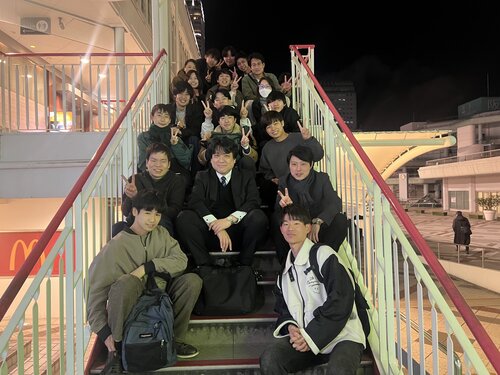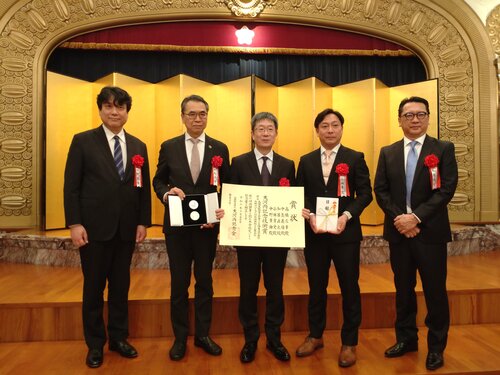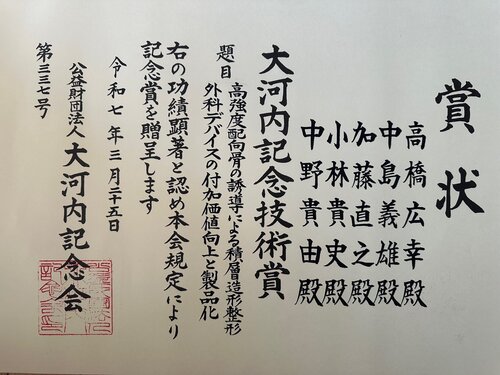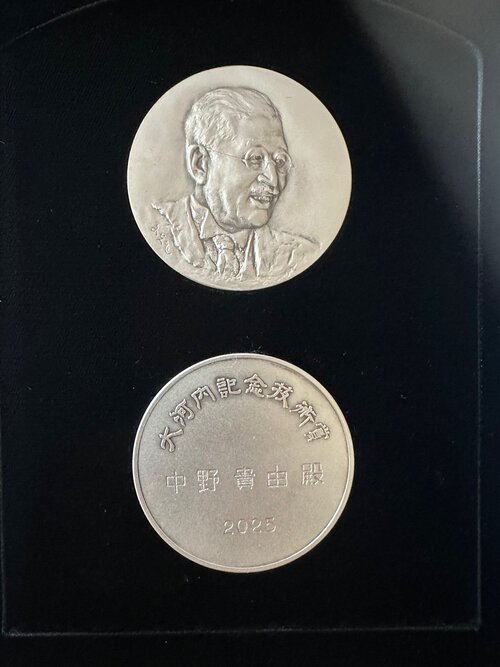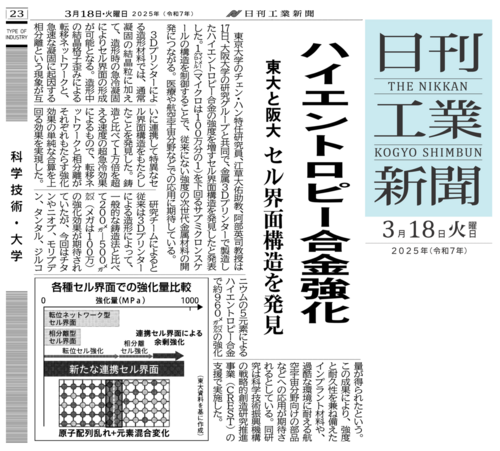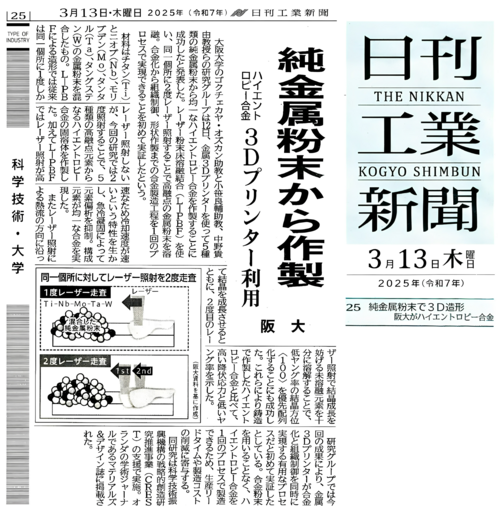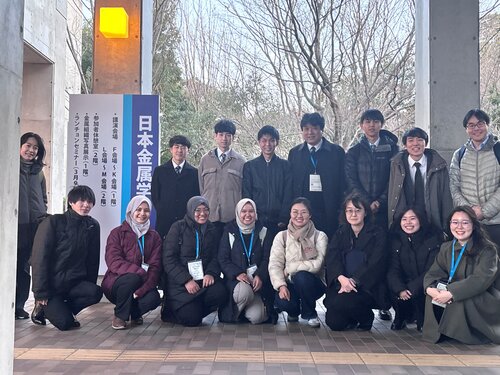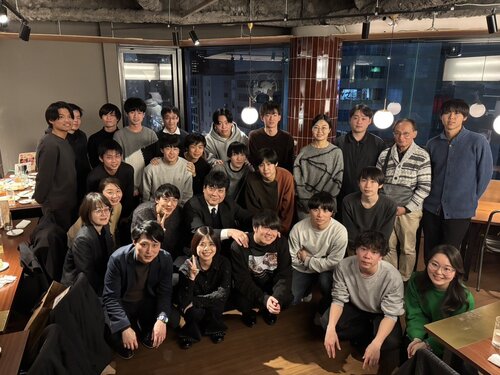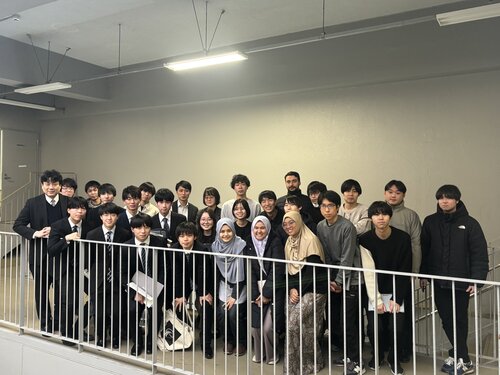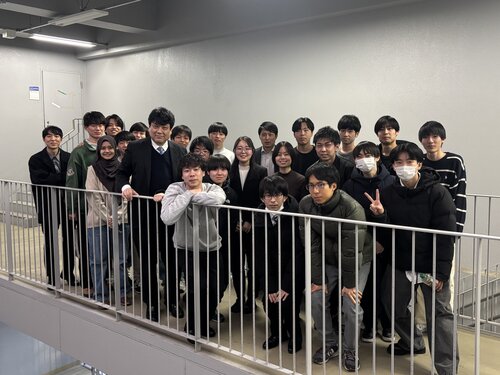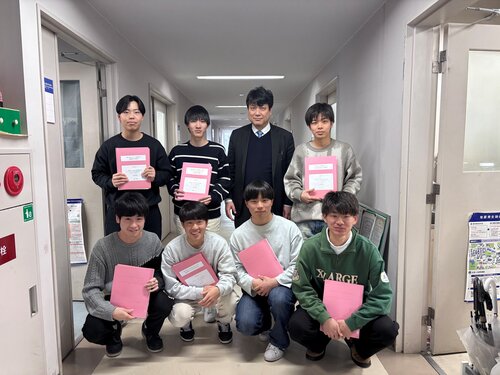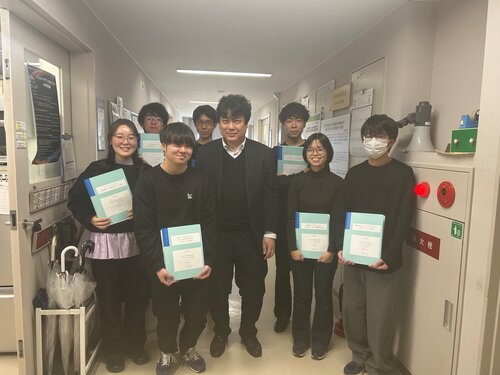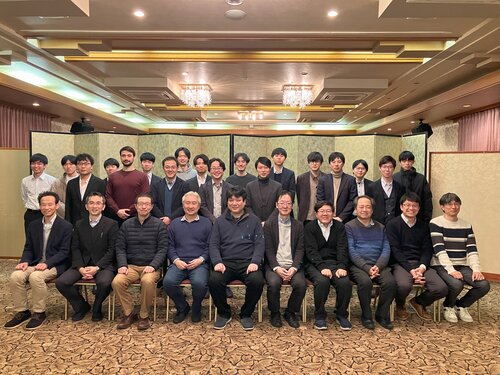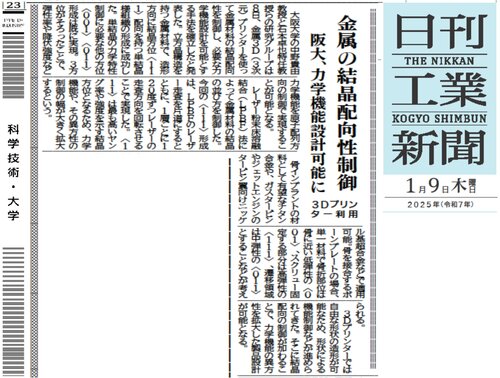最新情報
2025年(1月~6月)
-
2025.6.30
-
2025.6.28
-
2025.6.28
-
2025.6.26
-
2025.6.25
-
2025.6.25
-
2025.6.24
-
2025.6.21
-
2025.6.20
-
2025.6.19
-
2025.6.17
-
2025.6.16
-
2025.6.13
-
2025.6.12
-
2025.6.10
-
2025.6.10
-
2025.6.9
-
2025.6.5
-
2025.6.5
-
2025.6.1
-
2025.6.1
-
2025.5.28
-
2025.5.20
-
2025.5.5
-
2025.5.1
-
2025.5.1
-
2025.4.28
-
2025.4.23
-
2025.4.17
-
2025.4.14
-
2025.4.11
-
2025.4.11
-
2025.4.11
-
2025.4.10
-
2025.4.8
-
2025.4.3
-
2025.4.2
-
2025.3.27
-
2025.3.26
-
2025.3.25
-
2025.3.22
-
2025.3.21
-
2025.3.19
-
2025.3.18
-
2025.3.18
-
2025.3.17
-
2025.3.15
-
2025.3.15
-
2025.3.14
-
2025.3.14
-
2025.3.14
-
2025.3.13
-
2025.3.10
-
2025.3.9
-
2025.3.8
-
2025.3.8
-
2025.3.8
-
2025.3.8
-
2025.3.6
-
2025.3.4
-
2025.2.28
-
2025.2.27
-
2025.2.22
-
2025.2.22
-
2025.2.20
-
2025.2.19
-
2025.2.18
-
2025.2.18
-
2025.2.13
-
2025.2.12
-
2025.2.10
-
2025.2.7
-
2025.2.4
-
2025.1.26
-
2025.1.22
-
2025.1.17
-
2025.1.15
-
2025.1.14
-
2025.1.11
-
2025.1.9
-
2025.1.9
-
2025.1.8
-
2025.1.8
-
2025.1.8
-
2025.1.6
-
2025.1.1
-
2025.1.1
-
2025.6.30
【学会】中野研究室のメンバーが THERMEC2025(@University of Tours, France, 6月30日~7月4日)に参加します。
2025/6/30
Invited Speaker
〇Design of high entropy alloy with suppressed elemental segregation for laser powder bed fusion process
Ozkan Gokcekaya, Yong Seong Kim, Takayoshi Nakano
Invited Speaker
〇Electron Microscopy Studies on Orientation-Controlled 316L Austenitic Stainless Steel
Produced by Laser Powder Bed Fusion
Kazuhisa Sato, Shunya Takagi, Satoshi Ichikawa, Takuya Ishimoto, Takayoshi Nakano
2025/7/1
Keynote Speaker
〇Innovative design of crystallographic textures and macroscopic shapes via metal additive manufacturing
Takayoshi Nakano
Poster presentation
〇Unique Hierarchical Structural Features Introduced by Laser Powder Bed Fusion and Their Contribution to Mechanical Function in IN718
Taichi Kikukawa, Takuya Ishimoto, Tsuyoshi Mayama, Ryosuke Ozasa, Takayoshi Nakano
Poster presentation
〇Microstructural Control of Unstable Beta-Type Titanium Alloy Through Powder Bed Fusion Using a Laser-Beam of Metals
Keitaro Miyasawa, Ryosuke Ozasa, Daisuke Egusa, Eiji Abe, Masakazu Tane, Takayoshi NakanoInvited Speaker
〇Elastic properties of laser powder bed fusion processed β-phase Ti alloys
Masakazu Tane, Shota Higashino, Eisuke Miyoshi, Takuya Ishimoto, Takayoshi Nakano
Invited Speaker
〇Microstructure control of TiAl alloys using peculiar thermal history of additive manufacturing
Ken Cho, Hiroyuki Y. Yasuda, Masao Takeyama, Takayoshi Nakano
〇Novel cellular structure with phase-separation induced dislocation-network in Ti-Zr-Nb-Ta-Zr high entropy alloy fabricated by laser powder bed fusion
Daisuke Egusa, Han Chen, Ryosuke Ozasa, Masayuki Okugawa, Taisuke Sasaki, Takuya Ishimoto, Koizumi Yuichiro, Takayashi Nakano, Eiji Abe
Poster presentation
〇Spinodal Decomposition and Magnetic Properties of Single-Crystal-Like Fe-Cr-Co Alloy Fabricated by Laser-Powder Bed Fusion Type Additive Manufacturing
Takato Saito, Yuheng Liu, Masayuki Okugawa, Kazuhisa Sato, Takayoshi Nakano, Yuichiro Koizumi
2025/7/2
Invited Speaker
〇A Novel Strategy for the Control of Crystallographic Texture of Metals with Non-Cubic Crystal System via Powder Bed Fusion using a Laser-Beam of Metals
Ryosuke Ozasa, Koji Hagihara, Takayoshi Nakano
〇Discovery of nano-scaled promising strengthening factor in 316L stainless steel fabricated by laser
powder bed fusion
Fei Sun, Yoshitaka Adachi, Kazuhisa Sato, Takuya Ishimoto, Takayoshi Nakano, Yuichiro Koizumi
〇Nano-scaled solidification microstructure characteristics in additively manufactured 316L stainless steel
Fei Sun, Yoshitaka Adachi, Kazuhisa Sato, Takuya Ishimoto, Takayoshi Nakano, Yuichiro Koizumi
〇Influence of hierarchical structure on mechanical properties of additive manufactured IN718 alloys
Kippei Yamashita, Ken Cho, Hiroyuki Y. Yasuda, Takuma Saito, Taisuke Sasaki, Sawaizumi Katsuhiko, Masayuki Okugawa, Koizumi Yuichiro, Takayoshi Nakano
Invited Speaker
〇Growth of Antiphase Domain in Laser-Irradiated Region and Superelasticity of Single-Crystal Like Fe3Al Fabricated by Laser Powder Bed Fusion Process
Yuheng Liu, Tsubasa Sato, Masayuki Okugawa, Kazuhisa Sato, Hiroyuki Y. Yasuda, Takayoshi Nakano, Yuichiro Koizumi
2025/7/3
Invited Speaker
〇Additive Manufacturing of Cell-Based 3D Bone-Mimetic Collagen/Apatite Structures
Aira Matsugaki, Takayoshi Nakano
Invited Speaker
〇Control of Bone Microstructure Formation: Role of Soluble Proteins Secreted by Osteocytes
Tadaaki Matsuzaka, Aira Matsugaki, Takayoshi Nakano -
2025.6.28
【研究費】中野先生を代表とする、2025年度JSPS科学研究費補助金・挑戦的研究(開拓)が採択されました。
中野貴由:『聴こえる』を制御する骨基質ナノ構造の新奇機能開拓、科学研究費補助金・挑戦的研究(開拓)、2025年度~2027年度、直接経費2000万円(間接経費600万円)
-
2025.6.28
【学会】第45回日本骨形態計測学会(2025年6月26日~6月28日:埼玉)の表彰式に出席しました。
-
2025.6.26
【学会】第45回日本骨形態計測学会(2025年6月26日~6月28日:埼玉)に参加しています。
-
2025.6.25
【新聞】金属3Dプリンターを用いたナノ構造の形成と高強度化に関する記事が日刊工業新聞に掲載されました。
-
2025.6.25
【新聞】日本経済新聞電子版に3Dプリンティングに関する記事が掲載されました。
-
2025.6.24
【論文】【プレスリリース】Materials Research Letters誌に菊川君らが解明した3DプリンティングにおけるInconel 718における強力なセル強化に関する論文がOA論文として掲載されました。同時にプレスリリースし、6月24日14:00に報道解禁になりました。
Taichi Kikukawa, Takuya Ishimoto*, Hyoung Seop Kim, Takayoshi Nakano*:
Remarkable Strengthening Effects of Cells in Laser Powder Bed Fusion Processed Inconel 718,
Materials Research Letters, (2025).
DOI: https://doi.org/10.1080/21663831.2025.2522801
プレリリースはこちら
論文はこちら
PDFはこちら
Abstract
Alloys fabricated via laser powder bed fusion (LPBF) exhibit superior strength. This study investigates the individual strengthening effects of the nanometre-sized cellular and micrometre-sized crystallographic lamellar structures in the LPBF-fabricated Inconel 718 alloy by selectively eliminating these structures through heat treatment and a novel laser scanning strategy, respectively. While cellular structures increased the yield strength by approximately 38%, lamellar structures contributed to only a marginal 2% increase. This finding demonstrates the remarkable strengthening effect of cells on LPBF products. This study highlights that cells are not merely microstructures but are critical features governing the exceptional strength of LPBF products.
Keywords
Laser powder bed fusion; cellular microstructures; lamellar structure; single crystal; strengthening -
2025.6.21
【論文】チタン上へのNiTi被膜の電子ビーム造形による耐摩耗性の改善に関する論文がSurfaces and InterfacesにOA論文として公開されました。
Lei Wang, Masayuki Okugawa, Yuheng Liu , Ken Cho, Hiroyuki Y. Yasuda, Takayoshi Nakano, Yuichiro Koizumi:
NiTi coating formation on Ti for enhanced wear resistance utilizing electron-beam additive manufacturing technique,
Surfaces and Interfaces, 72, (2025), 107024; 1-14.
DOI: https://doi.org/10.1016/j.surfin.2025.107024
論文はこちら
PDFはこちら
Abstract
Titanium and its alloys are extensively utilized in various industries owing to their high corrosion resistance and excellent strength-to-weight ratio. However, their poor wear resistance limits further applications. The present study developed a novel method to fabricate wear-resistant NiTi coatings on commercially pure titanium (CP-Ti) substrates to overcome this limitation. The process comprises electroplating a pure Ni layer followed by fusion with the CP-Ti substrate by electron beam (EB) scanning. The surface roughness and composition of the coating can be fine-tuned by adjusting the EB irradiation conditions. For example, the average roughness of continuously scanned (CS) coatings is Ra 8.9, while the average roughness of intermittently scanned (IS) coatings is reduced by 60% compared to CS-coatings. Additionally, the Ni concentration in the IS-coatings can be finely adjusted from 45 at.% to 55 at.% by adjusting EB power. X-ray diffractometry (XRD) revealed that IS-coatings are partially composed of superelastic B2-NiTi phases. Nanoindentation and sliding wear tests demonstrated that the hardness-to-modulus (H/E) ratio and depth recovery ratio (ηd,h) of the IS-coating increased by a factor of 4.7 and 2.9 compared to those of CP-Ti, respectively. Additionally, the specific wear rate (Ws) of the IS-coating was reduced by 80% compared to CP-Ti. The mechanical properties of the IS-coating were comparable to those of superelastic NiTi alloy. This newly developed method offers potential applications beyond NiTi coatings, enabling the development of various functional coatings for enhanced wear resistance.
Keywords
Commercially pure Ti; NiTi; Coating; Shape-memory alloy; Mechanial properties; Superelasticity; Wear resistance -
2025.6.20
【論文】チタン上へのNiTi被膜の電子ビーム造形による耐摩耗性の改善に関する論文がSurfaces and Interfacesに受理されました。
Lei Wang, Masayuki Okugawa*, Yuheng Liu , Ken Cho, Hiroyuki Y. Yasuda, Takayoshi Nakano, Yuichiro Koizumi*
NiTi coating formation on Ti for enhanced wear resistance utilizing electron-beam additive manufacturing technique,
Surfaces and Interfaces, (2025), in press. -
2025.6.19
【論文】Materials Today Communicationsにレーザと電子線で作製したTi合金の力学的・電気化学的特性の異方性に関する論文が掲載されました。
Parinaz Mofazali, Masoud Atapour*, Ozkan Gokcekaya, Sung-Hyun. Park, Batur Ercan, Takayoshi Nakano: Comparison and Evolution of Ti6Al4V Bioalloy Fabricated by Laser and Electron beam Additive Manufacturing: Mechanical Features and Anisotropic Electrochemical Properties,
Materials Today Communications, (2025), 113124: 1-14.
DOI: https://doi.org/10.1016/j.mtcomm.2025.113124
論文はこちら
PDFはこちら
Abstract
With current technology, most biomedical implants are made using metal-based alloys, with a growing preference for metal additive manufacturing (AM) to achieve customized properties. Therefore, this study investigated Ti-6Al-4V (Ti64) alloys produced using two common AM techniques: electron beam melting (EBM) and selective laser melting (SLM). The aim is to compare the microstructure, mechanical properties, and anisotropy electrochemical corrosion behavior of Ti64 samples scanned with SLM-XX, SLM-XY, and EBM-XX strategies. Surface roughness, microstructure, and microhardness tests were conducted to establish correlations with the manufacturing process and surface characteristics. Optical and scanning electron microscopy microstructural analysis revealed notable variations influencing mechanical performance. Moreover, anisotropy-assessing electrochemical corrosion evaluations showed that SLM samples exhibited superior corrosion resistance compared to EBM samples. Notably, the (YZ) planes in the SLM-XY sample demonstrated the highest corrosion resistance (Rct ⁓ 4.45 ×106 Ω.cm2), attributed to reduced dislocation density and enhanced passivation. Furthermore, results showed that the method of fabrication affected the wettability of Ti64 alloys. The SLM-XY samples exhibited the lowest water contact angle (84.45°), whereas the EBM samples showed the highest (99.87°). Finally, bioactivity assessments after 21 days in simulated body fluid (SBF) revealed no cracking or surface damage in any of the tested samples. The formation of calcium- and phosphorus-rich deposits indicates their potential suitability for orthopedic applications.
Keywords
Ti6Al4V; SLM; EBM; Anisotropy; Corrosion; Biomedical -
2025.6.17
【論文】Materials Today Communicationsにレーザと電子線で作製したTi合金の力学的・電気化学的特性の異方性に関する論文が受理されました。
Parinaz Mofazali, Masoud Atapour*, Ozkan Gokcekaya, Sung-Hyun. Park, Batur Ercan, Takayoshi Nakano: Comparison and Evolution of Ti6Al4V Bioalloy Fabricated by Laser and Electron beam Additive Manufacturing: Mechanical Features and Anisotropic Electrochemical Properties, Materials Today Communications, (2025), in press.
-
2025.6.16
【論文】Materials Research Letters誌に菊川君らが解明した3DプリンティングにおけるInconel 718における強力なセル強化に関する論文が受理され、OA論文として掲載されます。
Taichi Kikukawa, Takuya Ishimoto*, Hyoung Seop Kim, Takayoshi Nakano*:
Remarkable Strengthening Effects of Cells in Laser Powder Bed Fusion Processed Inconel 718 Materials Research Letters, (2025), in press. -
2025.6.13
【論文】Postecとの共同研究の析出と格子ひずみの競合を利用した高強度・高延性ミドルハイエントロピー合金の国際共同研究が"Materials Science and Engineering A"に掲載されました。
Jae Heung Lee, Hyeonseok Kwon*, Gang Hee Gu, Ji Yeong Lee, Sang Guk Jeong, Emad Maawad, Changwan Ha, Jaemin Wang, Byeong-Joo Lee, Sangbong Yi*, Takayoshi Nakano, Hyoung Seop Kim*:
Harnessing competitive interplay between precipitation and lattice distortion for strong and ductile medium-entropy alloy,
Materials Science and Engineering A, 942, (2025) 148642: 1-11.
DOI: https://doi.org/10.1016/j.msea.2025.148642
論文はこちら
PDFはこちら
Abstract
In Co-Cr-Fe-Ni-Mo-C ferrous medium-entropy alloys (FeMEAs), precipitation-driven alteration of matrix composition affects both the kinetics of deformation-induced martensitic transformation (DIMT) and the degree of lattice distortion. While DIMT has been well studied, the role of lattice distortion remains explored. In this study, we simultaneously enhance the strength and ductility in Co18Cr13Fe57.5Ni7.5Mo3C1 (at%) FeMEA by harnessing the competitive interplay between precipitation and lattice distortion. Two annealed samples with similar grain sizes but different precipitate characteristics were prepared. The sample with suppressed precipitation exhibits improved ductility while maintaining comparable strength. The two specimens exhibited similar yield strengths due to a trade-off between precipitation strengthening and solid solution strengthening. However, the sample with higher lattice distortion and reduced precipitation demonstrates superior strain-hardening behavior owing to the lattice distortion-induced back stress, acting as an effective strain-hardening mechanism, and delayed DIMT, serving as a ductilizing mechanism. This work offers a strategy to modulate strengthening and deformation mechanisms in Co-Cr-Fe-Ni-Mo-C FeMEAs via precipitation control.
Keywords
Ferrous medium-entropy alloy; Precipitation; Deformation mechanism; Strengthening mechanismIn-situ synchrotron X-ray diffraction -
2025.6.12
【論文】バイオフィルムに関する研究が、Transactions of the IMF (YTIM)に受理されました。
Hideyuki Kanematsu*, Shochiku Kure, Risa Kawai, Hidekazu Miura, Takayoshi Nakano: Antibiofilm Potential of Graphene-Dispersed Alkoxysilane Coatings: A Materials Science Perspective Transactions of the IMF (YTIM), (2025), in press.
-
2025.6.10
【受賞】中野研究室D1の齊藤光郁さん、森陶子さんが第45回日本骨形態計測学会 若手研究者賞の受賞に内定しました。
齊藤光郁、「抗血液凝固薬投与はオステオカルシンの翻訳後修飾を介して骨基質配向性を変化させる」、2025年6月28日
森陶子、「チタン細線による骨基質配向性制御を介した早期脊椎再建」、2025年6月28日 -
2025.6.10
【学会】中野研究室のメンバーが日本骨形態計測学会(第45回)(@大宮ソニックシティ、6月27日~6月28日)に参加します。
イブニングセミナー
〇中野貴由、骨質指標としての骨基質配向性の基礎と応用、第45回日本骨形態計測学会、大宮ソニックシティ、2025年6月27日
シンポジウム
〇松垣あいら、基質配向性から見た骨質研究の最前線、第45回日本骨形態計測学会、大宮ソニックシティ、2025年6月27日
〇中野貴由、骨基質配向性を考慮した積層造形による脊椎間スペーサの開発と製品化、第45回日本骨形態計測学会、大宮ソニックシティ、2025年6月27日
一般公演
〇松坂匡晃、松垣あいら、中野貴由、応力刺激に基づく骨基質配向性の制御を介した機能適応、第45回日本骨形態計測学会、大宮ソニックシティ、2025年6月27日
〇松垣あいら、中野貴由、骨基質構造に基づく骨機能再建のための細胞制御マテリアル設計と開発、第45回日本骨形態計測学会、大宮ソニックシティ、2025年6月28日
〇森陶子、松垣あいら、文勝徹、海渡貴司、岡田誠司、中野貴由、チタン細線による骨基質配向性制御を介した早期脊椎再建、第45回日本骨形態計測学会、大宮ソニックシティ、2025年6月28日
〇齊藤光郁、松垣あいら、中野貴由、抗血液凝固薬投与はオステオカルシンの翻訳語就職を介して骨基質配向性を変化させる、第45回日本骨形態計測学会、大宮ソニックシティ、2025年6月28日〇小笹良輔、中野貴由、妊娠および授乳関連性骨粗鬆症における骨配向性とヤング率の変化、第45回日本骨形態計測学会、大宮ソニックシティ、2025年6月28日
-
2025.6.9
2025年6月9日 【講演】デンマーク工科大学(DIU)のDorte Juul Jensen教授が訪問し、講演を行っていただきました。最新のμAMプロジェクトの研究に対して議論が盛り上がりました。
デンマーク工科大学(DIU)のDorte Juul Jensen教授が訪問し、講演を行っていただきました。最新のμAMプロジェクトの研究に対して議論が盛り上がりました。
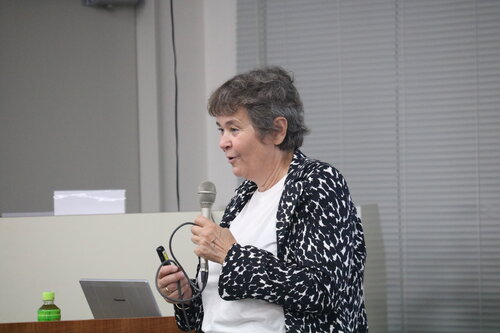
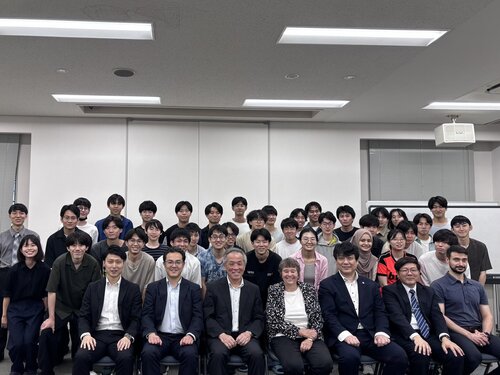
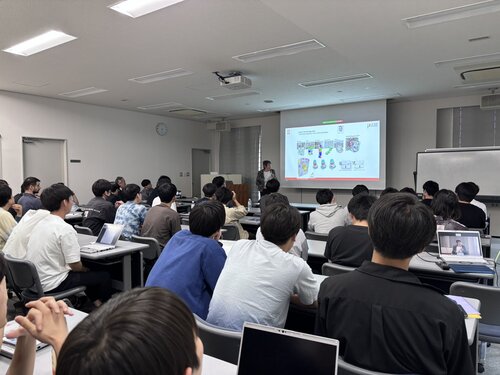
R4 building 2F Seminar Room, Suita Campus, Osaka University
・Microstructural Characterization of Metals in 2D, 3D and 4D
・Microstructural Engineering of Additively Manufactured Metals
Prof. Dr. Dorte Juul Jensen
Technical University of Denmark -
2025.6.5
2025年6月5日【訪問】Northeastern UniversityのProf. Xiaoli Zhao先生が中野研を訪問くださいました。
-
2025.6.5
【論文】Postecとの共同研究の析出と格子ひずみの競合を利用した高強度・高延性ミドルハイエントロピー合金の国際共同研究が"Materials Science and Engineering A"に受理されました。
Jae Heung Lee, Hyeonseok Kwon*, Gang Hee Gu, Ji Yeong Lee, Sang Guk Jeong, Emad Maawad, Changwan Ha, Jaemin Wang, Byeong-Joo Lee, Sangbong Yi*, Takayoshi Nakano, Hyoung Seop Kim*:
Harnessing competitive interplay between precipitation and lattice distortion for strong and ductile medium-entropy alloy,
Materials Science and Engineering A, (2025), in press. -
2025.6.1
2025年6月1日・2日 【研究会】いよいよ5年目に入ったJST-Crestのチーム内(大阪大・東京大・熊本大・名古屋大)対面会議を行いました。
-
2025.6.1
【学会】日本材料学会第74期学術講演会(@日本大学工学部、5月30日~6月1日)に参加し、以下の発表を行いました。
-
2025.5.28
【受賞】松垣先生、小笹先生、Gokcekaya先生が粉体粉末冶金協会 2024年度研究進歩賞を受賞しました。 京都大学 宇治キャンパスで授賞式が行われました。
-
2025.5.20
2025年5月20日 【学会】中野先生が会長を務める(一社)日本Additive Manufacturing学会(日本AM学会)の第一回セミナーが東京で開催されました。
中野先生が会長を務める(一社)日本Additive Manufacturing学会(日本AM学会)の第一回セミナーが東京で開催されました。 現地は定員一杯の約150名の参加、さらにWEBでの150名以上の参加(合計300名以上)があり、大変好評でした。すでに69社の企業賛助会員、約700名の入会となっております。 本セミナーでは、「AM×最先端技術(宇宙・自動車・医療)」を趣旨とし、産学官から多彩な講師陣が登壇し、最新の技術動向や事例紹介、今後の課題などが議論されました。 さらに、参加者同士のネットワーキングの場も設けられ、異分野間の連携促進や技術交流の機会となりました。
-
2025.5.5
【依頼論文】デンタルインプラントの荷重と骨質に関する論文が、日本補綴歯科学会誌に掲載されました。
黒嶋伸一郎, 中野貴由, 澤瀬 隆:
荷重がインプラント周囲の骨質に与える影響を科学する,
日本補綴歯科学会誌, 17 [2], (2025), 69-76.
https://doi.org/10.2186/ajps.17.69
抄録
本依頼論文は,研究から得られた科学的情報に基づいて,骨質の概念と力に対する骨組織の応答性を正しく理解することであり,著者らが行ってきた骨質に関する一連の基礎的研究と非臨床試験について検討した.その結果,動物種(部位特異性はある)によらず,インプラントに荷重を付与すると,オッセオインテグレーション,骨量,骨密度,骨質が大きく変化した.また,骨質を変化(向上)させるデンタルインプラントの存在が確認できた.したがって,骨質は骨密度とは独立した概念で,同義でもなく類似もしておらず,荷重環境下ではインプラントデザインによりインプラント周囲の骨質が大きく変化することがわかった. -
2025.5.1
【受賞】中野貴由教授が、箕面商店(町田商店)の『完まくランキング』にて、他の追随を許さない"4倍超"の大差で第1位を獲得しました。
この快挙の裏側には、中野研究室のメンバーが自然と生み出した連帯感があります。
同じ目標に向かい、同じ空気を共有した瞬間、中野研の団結力がひとつの"圧倒的結果"となって表れました。 -
2025.5.1
【解説】まてりあの5月号が発行され、中野先生の本多記念講演の内容の解説記事が掲載されています。
中野貴由:
異方性材料デザインにより材料を主役に~耐熱性金属間化合物から,骨組織,金属3Dプリンティングによる生体材料まで、
まてりあ, 64 [5], (2025), pp. 317-330. (第70回本多記念講演)
http://www.mat.eng.osaka-u.ac.jp/msp6/nakano/a51e100a9d882a8debb79a21ae0abdb9dce8996a.pdf -
2025.4.28
【行事】中野研究室恒例の新入生歓迎BBQを行いました。
-
2025.4.23
【受賞】齊藤さん、森さんが大阪大学女子大学院生優秀研究賞を受賞しました。
-
2025.4.17
【受賞記事】日本バイオマテリアル学会誌に大河内賞受賞に関する記事が掲載されました。
第71回(令和6年度)大河内記念技術賞、バイオマテリアルー生体材料―、43 [2], (2025), 176.
PDFはこちら -
2025.4.14
【関西大阪万博(Expo)】石黒先生のパビリオンで中野研の技術が紹介されています。
当パビリオン(石黒パビリオン)について→
https://expo2025future-of-life.com/about/50年後の世界を実現する「近未来の」技術(未来技術シーズ)→
https://expo2025future-of-life.com/about/future-technology-seeds/医療技術→
https://expo2025future-of-life.com/about/future-technology-seeds/
★再生初期から強固な骨を誘導できる夢の骨医療デバイス
(中野研の技術)
骨などの生体組織の「方向によって特性が異なる性質」(異方性)の仕組みを原子レベルで解明する研究を進め、その知見を材料開発に応用。金属3Dプリンタで形状や原子配列を制御することで、個人ごとや部位ごとにフィットした再生初期から強固で健康な骨を作り出す世界初・日本発の骨医療デバイスの開発に成功した。医療現場での実用化を実現し、患者さんの早期の社会復帰を可能にしている。大阪大学大学院工学研究科マテリアル生産科学専攻 中野貴由研究室
http://www.mat.eng.osaka-u.ac.jp/msp6/nakano/research/
https://www.eng.osaka-u.ac.jp/prospective/introduction-research/869/ -
2025.4.11
【新聞】AM触媒に関するNature Communicationsの論文が科学新聞で紹介されました。
-
2025.4.11
【新聞】大阪大学山下・森研と中野研の共同研究による金属3Dプリンターを用いた低温メタネーション触媒に関する記事が日刊工業新聞に掲載されました。
-
2025.4.11
【論文】Metallurgical and Materials Transactions A誌にTi合金のクリープ特性の向上に関する論文が掲載されました。
Prince Valentine Cobbinah*, Sae Matsunaga, Yoshiaki Toda, Ryosuke Ozasa, Takuya Ishimoto, Takayoshi Nakano, Tsutomu Ito, Yoko Yamabe-Mitarai:*
On the enhanced creep performance in Ti6246 achieved through Laser Powder Bed Fusion (LPBF) processing,
Metallurgical and Materials Transactions A, (2025).
DOI: https://doi.org/10.1007/s11661-025-07759-8
論文はこちら
PDFはこちら
Abstract
The high susceptibility of the Ti-6Al-2Sn-4Zr-6Mo wt pct (Ti6246) alloy to microstructural changes stands as a challenge when processed by the laser powder bed fusion (LPBF) technology. However, leveraging the capabilities of the LPBF process to successfully control the microstructure (and/or crystallographic texture) of the Ti6246 could improve mechanical properties, particularly at elevated temperatures. In this study, the creep performance (at 500 °C) of Ti6246 fabricated from three different LPBF processing conditions and heat-treated (HT) at 885 °C were investigated. In the as-built state, all the LPBFed-Ti6246 exhibited columnar microstructures with crystallographic lamellar-like microstructure (CLM), a near-single crystal-like microstructure (SCM), and polycrystalline microstructure (PCM) textures, respectively. At low applied stresses (100-300 MPa), diffusional creep was the dominant deformation mechanism and its resistance depended on grain size. The reference β-forged-HT Ti6246, characterized by large equiaxed grains, exhibited the lowest strain rate compared to the columnar microstructure of SX1 (CLM)-HT, SX2 (SCM)-HT, and SX3 (PCM)-HT. Conversely, dislocation slip governed deformation at high applied stresses (400-580 MPa) and its efficacy depended on the α/β interfaces in the microstructures. Disjointed columnar grains in SX1 (CLM)-HT and the deformation of the polycrystalline grains in SX3 (PCM)-HT indicated that the melt pool boundaries were unstable in the LPBFed-Ti6246. SX2 (SCM)-HT exhibited the longest creep life due to the relatively stable melt pool boundaries and the near < 001 > SCM crystallographic texture parallel to the applied stresses. Shallow ductile dimples and tears and the observation of laser scan tracks characterized the fracture surfaces of the LPBFed-Ti6246. These indicated that failure occurred by intergranular ductile fracture resulting from the formation of microvoids at the melt pool boundaries. -
2025.4.10
【新B4配属】4年生が8名(太田君、小倉君、柴田君、永野君、西岡君、溝上君、横山君、渡邊君)配属され、新入生歓迎会を行いました!
-
2025.4.8
Journal of Biomaterials Applications誌にDCPDコーティングβ-TCPから低結晶性β-TCP多孔質スキャフォールドへの新しい2段階変換に関する論文が掲載されました。
Ahmed Hafedh Mohammed Mohammed, Khairul Shariff, Mohamad Hafizi Abu Bakar, Ali Salman, Aira Matsugaki, Takayoshi Nakano, Intan Nirwana, alexander patera nugraha:
A novel two-step conversion from DCPD-coated β-TCP to low crystallinity β-TCP porous scaffolds via combination between dry heating and hydrothermal methods: Effects on pre-osteoblast cell responses,
Journal of Biomaterials Applications, (2025), in press.
DOI: https://doi.org/10.1177/08853282251333231
論文はこちら
Abstract
This study presents a novel two-step process to fabricate low crystallinity (LC) β-tricalcium phosphate (β-TCP) porous scaffolds and evaluates their implications for pre-osteoblast cell responses. The novelty of this study lies in the two-step conversion of dicalcium phosphate dihydrate (DCPD) -coated β-TCP porous scaffold into LC β-TCP porous scaffolds through a combination of dry heating and hydrothermal conditions at 200°C. The obtained LC β-TCP porous scaffolds were characterised using a Scanning Electron Microscope (SEM), X-Ray Diffraction (XRD), Fourier-Transform Infrared (FTIR), porosity, and compressive strength analysis confirmed the successful fabrication of LC β-TCP scaffolds. Besides, in vitro tests using pre-osteoblast MC3T3-E1 cells were conducted to investigate the cell responses toward LC β-TCP porous scaffolds. The results revealed that the LC β-TCP porous scaffolds were successfully fabricated by converting the DCPD-coated β-TCP into the dicalcium phosphate anhydrous (DCPA) coated β-TCP, followed by a hydrothermal process in a 0.1 mol/L calcium chloride (CaCl2) aqueous solution at 200°C for 24 hours to obtain LC of pure β-TCP scaffold. Moreover, in vitro cell study indicated that the cell density and proliferation surrounding the surface of the LC β-TCP porous scaffold were greater than DCPD-coated β-TCP porous scaffolds. The findings from this study are expected to significantly impact bioceramic technology by enhancing cell responses. -
2025.4.3
【行事】中野研究室の新M1歓迎会が行われました。
本日、新M1歓迎会が行われました。内部進学者の中野研出身6名と英語コースで1名の合計7名が配属になりました。今年度から中野研の一員となった閻さんも加わり、より一層賑やかな研究室がスタートします。4月9日には新B4が配属されます。
-
2025.4.2
【論文&プレスリリース】大阪大学山下・森研と中野研の共同研究によるAM触媒に関する研究がプレスリリースされるとともに、Nature Communicationsに掲載されました。
【温室効果ガスを都市ガスに変換!金属3Dプリンターで低温メタネーション自己触媒反応器を開発~炭素循環社会に貢献するCO₂リサイクル技術~】
大阪大学大学院工学研究科KIM Hyojin特任助教、森浩亮教授、中野貴由教授、山下弘巳名誉教授、大阪大学超高圧電子顕微鏡センターの市川聡特任教授(常勤)らの研究グループは、レーザー金属3Dプリンティング技術と表面改質処理を組み合わせることで、ほぼ100%の選択性で、温室効果ガスの二酸化炭素(CO₂)を都市ガスの主成分であるメタン(CH₄)に変換できる金属製自己触媒反応器の作製に成功しました。
Hyo-Jin Kim, Kohsuke Mori*, Satoshi Ichikawa, Takayoshi Nakano, Hiromi Yamashita:
Layered Na₂Ti₃O₇-supported Ru catalyst for ambient CO₂ methanation,
Nature Communications, 16, (2025), 2697; 1-9.
DOI: https://doi.org/10.1038/s41467-025-57954-9
論文はこちら
PDFはこちら
プレスリリースはこちらAbstract
The methanation of CO₂ offers a practical solution for storing renewable energy and mitigating global climate risks. However, the primary challenge lies in achieving efficient CH4 production at lower temperatures. Here, we report a layered Na₂Ti₃O₇-supported Ru catalyst as a stabilizer of low-valence Ru that enables CO2 activation at low temperatures. This catalyst leads to a CH₄ production rate of 33.6 and 139.1 mmol gcat⁻¹h⁻¹ at 140 and 180 °C, respectively, with a gas hourly space velocity of 24,000 mL g⁻¹ h⁻¹ at ambient pressure (1 bar), significantly surpassing state-of-the-art catalysts performance. Moreover, the catalyst demonstrates robustness to on-off intermittency and 220-hour long-term stability tests, indicating its reliability under challenging conditions. The catalyst is also successfully synthesized at the gram scale and on a 3D-printed metal self-catalytic reactor by a facile ion-exchange method, confirming its excellent scalability. This study marks a significant step forward in the design of catalysts for the low temperature CO₂ hydrogenation. -
2025.3.27
【論文】Metallurgical and Materials Transactions Aに東京大学御手洗教授との共同研究としての積層造形Ti合金の高温クリープに関する研究成果が受理されました。
Prince Valentine Cobbinah*, Sae Matsunaga, Yoshiaki Toda, Ryosuke Ozasa, Takuya Ishimoto, Takayoshi Nakano, Tsutomu Ito, Yoko Yamabe-Mitarai:*
On the enhanced creep performance in Ti6246 achieved through Laser Powder Bed Fusion (LPBF) processing,
Metallurgical and Materials Transactions A, (2025), in press. -
2025.3.26
【記事】"医療や航空宇宙分野など、特殊な環境下での使用を可能とする次世代の材料開発"に関する記事が日経クロステックに掲載されました。
3Dプリンターでハイエントロピー合金、強さの理由はセル界面構造
URLはこちら -
2025.3.25
【受賞】帝人ナカシマメディカルと中野研で共同開発したUNIOS PLスペーサーが大河 内記念技術賞を受賞しました。日本工業倶楽部で贈賞式が行われました。
-
2025.3.22
【シンポジウム講演】中野先生が再生医療学会学術総会でシンポジウム講演を行いました。
中野貴由:骨基質配向性からみた骨再生と3Dプリンターによる脊椎スペーサーの臨床応用、
シンポジウム34 骨の再生、再生医療学会総会、第7会場 パシフィコ横浜 ノース 4F G402、
2025年3月22日 (土) 8:30~10:30 -
2025.3.21
【論文】Journal of Biomaterials Applicationsにリン酸カルシウムに関する研究が受理され、OA論文として掲載される予定です。
Ahmed Hafedh Mohammed Mohammed, Khairul Shariff, Mohamad Hafizi Abu Bakar, Ali Salman, Aira Matsugaki, Takayoshi Nakano, Intan Nirwana, alexander patera nugraha:
A novel two-step conversion from DCPD-coated β-TCP to low crystallinity β-TCP porous scaffolds via combination between dry heating and hydrothermal methods: Effects on pre-osteoblast cell responses,
Journal of Biomaterials Applications, (2025), in press. -
2025.3.19
【プレスリリース】金属3Dプリンター用いた高強度のハイエントロピー合金の作製に関する記事が日経クロステックに掲載されました。
阪大、金属3Dプリンター使い高強度のハイエントロピー合金を1工程で作製
URLはこちら -
2025.3.18
【新聞】JST-Crestの成果として、ハイエントロピー合金の強度を増す金属3Dプリンター特有のセル界面構造を発見したことが日刊工業新聞に掲載されました。
-
2025.3.18
【国際会議論文】AMの計算機シミュレーションに関する研究がJournal of the Japan Society of Powder and Powder Metallurgyに掲載されました。
Shuhei Mino, Masayuki Okugawa, Takayoshi Nakano, Yuichiro Koizumi:
Raking and Fusing Behaviors during Fabrication of Multiple-layers in Powder Bed Fusion: An integrated discrete Element and computational thermal fluid Dynamics Study
Journal of the Japan Society of Powder and Powder Metallurgy, 72, (2025), 16P-T6-11; S1465-S1469.
https://doi.org/10.2497/jjspm.16P-T6-11
論文はこちら
PDFはこちら
Abstract
In the powder bed fusion (PBF) type additive manufacturing (AM), understanding the relationship between the quality of the powder bed and the powder spreading process is crucial to avoiding defect formation. In this study, we investigated the powder-raking behavior during the multiple-layer fabrication process by discrete element method (DEM) and computational thermal-fluid dynamics (CtFD) simulations. The integrated PBF process simulation revealed that the gap height between the powder spreading blade and the build platform increases nonlinearly with the number of stacking layers, and accordingly, the powder-covered area ratio increases in the formed powder beds and affects the melt pool shapes. The powder raking behavior and melting and solidification behavior are related to each other, and both the powder raking and the irradiation conditions need to be optimized to obtain a high-quality part in the PBF process.Keywords
additive manufacturing; powder bed fusion; discrete element method; computational thermal-fluid dynamics -
2025.3.17
【プレスリリース】東京大学と大阪大学、JSTは、"医療や航空宇宙分野など、特殊な環境下での使用を可能とする次世代の材料開発"に関する研究成果を共同でプレスリリースしました。
ハイエントロピー合金をより強化する
新たなセル界面構造の発見
ー3Dプリンティング材料設計の新展開ー
PDFはこちらから→
http://www.mat.eng.osaka-u.ac.jp/msp6/nakano/26fbd8ddfa0f4531cc28f227ceb141c0ca38da48.pdf
JSTプレスリリースはこちらから→
https://www.jst.go.jp/pr/announce/20250317/index.html
日本経済新聞電子版はこちらから→
https://www.nikkei.com/article/DGXZRSP688410_X10C25A3000000/ -
2025.3.15
【論文】Additive Manufacturing誌(IF=10.3)にTi合金のヤング率予測に関する論文がOA論文として掲載されました。
Shota Higashino, Daisuke Miyashita , Takuya Ishimoto, Eisuke Miyoshi, Takayoshi Nakano, Masakazu Tane*:
Low Young's modulus in laser powder bed fusion processed Ti-15Mo-5Zr-3Al alloys achieved by the control of crystallographic texture combined with the retention of low-stability bcc structure,
Additive Manufacturing, 102 (2025), 104720; 1-13.
https://doi.org/10.1016/j.addma.2025.104720
論文はこちら
PDFはこちら
Abstract
Metastable β (body-centered cubic)-phase Ti alloys, quenched from a high-temperature β-phase field, have attracted great interest as biomedical implants, owing to their low Young's modulus. Recently, the application of additive manufacturing (AM) to β-phase Ti alloys has gathered much attention, because the AM process can form anisotropic crystallographic texture in which an elastically soft direction is preferentially oriented, resulting in low Young's modulus in a specific direction. However, the effects of anisotropic texture and microstructure formed by the AM process on anisotropic elastic properties have not been clarified in detail. In the present study, we measured all the independent elastic stiffness components of β-phase Ti-15Mo-5Zr-3Al (mass%) alloys, prepared by bidirectional scanning with (XY-scan) and without (X-scan) an interlayer rotation of 90° in laser powder bed fusion (LPBF), one of the AM processes, using resonant ultrasound spectroscopy. The measurements revealed that the LPBF-processed Ti alloys exhibited strong elastic anisotropy and a low Young's modulus (below 60 GPa) in the <100>-oriented direction of the alloy prepared by the XY-scan. Furthermore, micromechanics calculations based on Eshelby's inclusion theory revealed that the single crystal constituting the alloys prepared by LPBF had almost the same elastic stiffness as that of a single crystal prepared by the floating zone melting, which indicated that the metastable β phase was retained by suppressing an easily occurring β- to ω-phase transformation during LPBF. These results indicate that texture control combined with retention of the metastable β phase by LPBF achieves biocompatible low Young's modulus.
Keywords
Laser powder bed fusion; Elastic properties; Titanium alloys; Crystallographic texture; ω phase transformation -
2025.3.15
【論文】金属3Dプリンタによる合金化・組織制御・形状制御のワンプロセス実現についてMaterials & Designに掲載されました。
Yong Seong Kim, Ozkan Gokcekaya*, Kazuhisa Sato, Ryosuke Ozasa, Aira Matsugaki, Takayoshi Nakano*:
In-situ alloying of nonequiatomic TiNbMoTaW refractory bio-high entropy alloy via laser powder bed fusion: Achieving suppressed microsegregation and texture formation,
Materials & Design, 252, (2025), 113824; 1-18.
https://doi.org/10.1016/j.matdes.2025.113824
論文はこちら
PDFはこちら
Abstract
High-entropy alloys (HEAs) have attracted considerable attention owing to their excellent properties. However, the severe segregation of the constituent elements remains a common challenge in refractory HEAs. Recently, an approach to suppress segregation was proposed using laser powder bed fusion (LPBF) owing to the ultra-high cooling rates during solidification. Despite the advantages of LPBF, the persistent microsegregation between the dendritic and interdendritic regions of refractory HEAs and costly gas atomization process hinder the further development. To address these challenges, a novel nonequiatomic TiNbMoTaW refractory HEA was designed to minimize the difference between the liquidus and solidus temperatures to prevent segregation and phase separation for a better biological performance. In-situ alloying was implemented instead of costly and time-consuming gas atomization process. The segregation of constituent elements was suppressed by remelting, resulted in epitaxial growth and development of crystallographic texture, consequently reducing residual stress. The mechanical properties were improved due to the increase of solid solution strengthening and densification. It showed superior mechanical strength and equivalent biocompatibility compared to conventional biomaterials, indicating its superiority as a biomaterial. This study represents the first successful control of crystallographic texture through in-situ alloying of BioHEAs for next-generation biomaterials.
Keywords
High entropy alloys; Additive manufacturing; In-situ alloying; Crystallographic texture; Segregation -
2025.3.14
純金属粉末から作製 ハイエントロピー合金 3Dプリンター利用、日刊工業新聞、2025年3月13日朝刊、25面
-
2025.3.14
【論文】東京大学阿部研とのAMに関する共同研究の成果がAdditive Manufacturing誌(IF=10.3)に掲載されました。
Han Chen, Daisuke Egusa*, Zehao Li, Taisuke Sasaki, Ryosuke Ozasa , Takuya Ishimoto, Masayuki Okugawa, Yuichiro Koizumi, Takayoshi Nakano, Eiji Abe*
Phase-separation induced dislocation-network cellular structures in Ti-Zr-Nb-Mo-Ta high-entropy alloy processed by laser powder bed fusion,
Additive manufacturing, 102, (2025), 104737; 1-14.
https://doi.org/10.1016/j.addma.2025.104737論文はこちら
PDFはこちら
Abstract
Hierarchical structures, such as cellular structures, elemental segregations, and dislocation-network, are often proposed to enhance the mechanical properties of high-entropy alloys (HEAs) fabricated via additive manufacturing (AM). The formation of cellular structures is often attributed to elemental segregation during the solidification process or thermal strain resulting from the AM process. Here, we present a novel cellular structure where phase-separation and dislocation-network coupled in Ti-Zr-Nb-Mo-Ta HEA processed by laser powder bed fusion (L-PBF). Electron microscopy observations and X-ray diffraction (XRD) analyses show that this unique cellular structure consists of Zr-rich and Ta-rich body-center cubic (BCC) phases as the cell-wall and the cell-core, respectively, with their lattice constant difference of about 1 %. Moreover, a higher density of dislocations forming distinct networks is detected within this cellular structure, whose density reached 8 × 10 14 m 2 . Ma chine learning analysis reveals that the dislocations preferentially occur on the Zr-rich BCC side, thus accom modating the strains significant around the boundaries between the two BCC phases. With the aid of thermodynamic simulations, we propose a formation mechanism of the present cellular structure, which is governed by the elemental partitioning behavior of Zr and Ta during a solid-state phase separation under rapid cooling. Boundaries with this phase separation are introduced as semi-coherent interfaces with misfit disloca tions, introducing a high-density dislocation in the present material. This novel cellular structure can signifi cantly enhance the strength of AM HEAs, providing valuable insights for developing high-performance AM metals through the design of hierarchical microstructures.Keywords
High-entropy alloy; Laser powder bed fusion; Cellular structure; Phase separation; Dislocation-network; Electron microscopy; Machine learning -
2025.3.14
【プレスリリース】JSTと大阪大学は、中野JST-CRESTの成果として、"合金化と組織制御を同時に実現可能な新たな材料創製法"に関する研究成果を共同でプレスリリースしました。
金属3Dプリンタが切り拓くモノづくりの新時代!
純金属混合粉末×金属3Dプリンタでハイエントロピー合金を実現
―ワンプロセスで合金製造する新手法―
PDFはこちらから→
http://www.mat.eng.osaka-u.ac.jp/msp6/nakano/617b0457e17024a6ff1bfe687d5c7aa67edf2180.pdf
JSTプレスリリースはこちらから→
https://www.jst.go.jp/pr/announce/20250312/index.html
日本経済新聞電子版はこちらから→
https://www.nikkei.com/article/DGXZRSP688227_S5A310C2000000/
OPTORONICS ONLINEはこちらから→
https://optronics-media.com/news/20250313/98450/ -
2025.3.13
【記事】シグネチャーパビリオン「いのちの未来」HPがリニューアルオープンし、「未来の技術」シーズのページに中野研に関する記事が掲載されました。
再生初期から強固な骨を誘導できる夢の骨医療デバイス
トップページはこちらから→
https://expo2025future-of-life.com/
未来の技術シーズトップページはこちらから→
https://expo2025future-of-life.com/about/future-technology-seeds/
「ロボット・AT技術」「医療技術」「環境・エネルギー技術」それぞれのボタンを切り替えてご覧ください。 -
2025.3.10
【学会】日本金属学会2025年(第176回)春期講演大会(@東京都立大学、3月8日~3月10日)に参加しています。
-
2025.3.9
【論文】東京大学阿部研とのAMに関する共同研究の成果がAdditive Manufacturing誌(IF=10.3)に受理されました。
Han Chen, Daisuke Egusa*, Zehao Li, Taisuke Sasaki, Ryosuke Ozasa , Takuya Ishimoto, Masayuki Okugawa, Yuichiro Koizumi, Takayoshi Nakano, Eiji Abe*
Phase-separation induced dislocation-network cellular structures in Ti-Zr-Nb-Mo-Ta high-entropy alloy processed by laser powder bed fusion,
Additive manufacturing, in press (2025). -
2025.3.8
【受賞】日本金属学会2025年春期講演大会にて中野研関連の3件が、第72回日本金属学会論文賞を受賞しました。
●第72回日本金属学会論文賞
【組織部門】
Fei Sun, Toshio Ogawa, Yoshitaka Adachi, Kazuhisa Sato, Shunya Takagi, Goro Miyamoto, Asuka Suzuki, Akinori Yamanaka, Nobuo Nakada, Takuya Ishimoto, Takayoshi Nakano, Yuichiro Koizumi: Modulated Structure Formation in Dislocation Cells in 316L Stainless Steel Fabricated by Laser Powder Bed Fusion (Materials Transactions 64巻 6号)
【力学特性部門】
Koji Hagihara, Toko Tokunaga, Kazuki Yamamoto, Michiaki Yamasaki, Tsuyoshi Mayama, Takumi Shioyama, Yoshihito Kawamura, Takayoshi Nakano: Unified Understanding of Strengthening Mechanisms Acting in Mg/LPSO Two-Phase Extruded Alloys with Varying LPSO Phase Volume Fraction (Materials Transactions 64巻 4号)
【材料プロセシング部門】
Yuheng Liu, Kazufumi Nose, Masayuki Okugawa, Yuichiro Koizumi, Takayoshi Nakano: Fabrication and Process Monitoring of 316L Stainless Steel by Laser Powder Bed Fusion with μ-Helix Scanning Strategy and Narrow Scanning Line Intervals (Materials Transactions 64巻 6号) -
2025.3.8
【受賞】日本金属学会2025年(第176回)春期講演大会ポスターセッションにて、M1の菊川君、B4の磯谷君、大川君が優秀ポスター賞を受賞しました。
PBF-LB/M を利用した人工界面の形成と高強度化の機序解明
○菊川泰地、石本卓也、眞山剛、小笹良輔、中野貴由
優秀ポスター賞、東京都立大学、2025年3月8日
骨粗鬆症による骨基質配向性への影響
○磯谷太一、松垣あいら、中野貴由
優秀ポスター賞、東京都立大学、2025年3月8日
L-PBFにより造形したLPSO型Mg合金の力学特性
○大川翔、小笹良輔、萩原幸司、松本敏治、中野貴由
優秀ポスター賞、東京都立大学、2025年3月8日 -
2025.3.8
【論文】金属3Dプリンタにより合金化・組織制御・形状制御をワンプロセス実現についてMaterials & Designに受理されました。
Yong Seong Kim, Ozkan Gokcekaya*, Kazuhisa Sato, Ryosuke Ozasa, Aira Matsugaki, Takayoshi Nakano*:
In-situ alloyed nonequiatomic TiNbMoTaW bio-high entropy alloy (BioHEA) by laser powder bed fusion: Suppressed microsegregation and crystallographic texture formation,
Materials & Design, (2025) in press. -
2025.3.8
【講演】中野先生が第70回本多記念講演を行いました。
中野貴由: 異方性材料デザインにより材料を主役に
~耐熱性金属間化合物から、骨組織、金属3Dプリンティングによる生体材料まで~、
東京都立大学(日本金属学会2025年春期(第176回)講演大会)、2025年3月8日、10:50~11:45
講演資料はこちらから→
http://www.mat.eng.osaka-u.ac.jp/msp6/nakano/62217808eb12335b58aed3d13297eda27d9570a8.pdf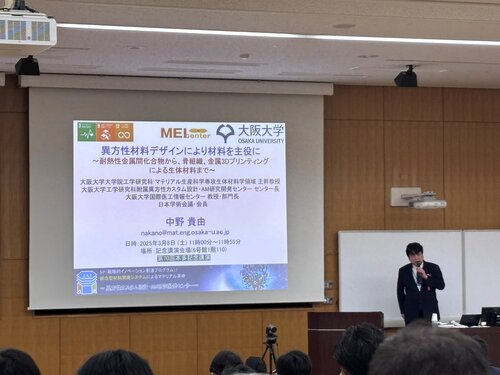
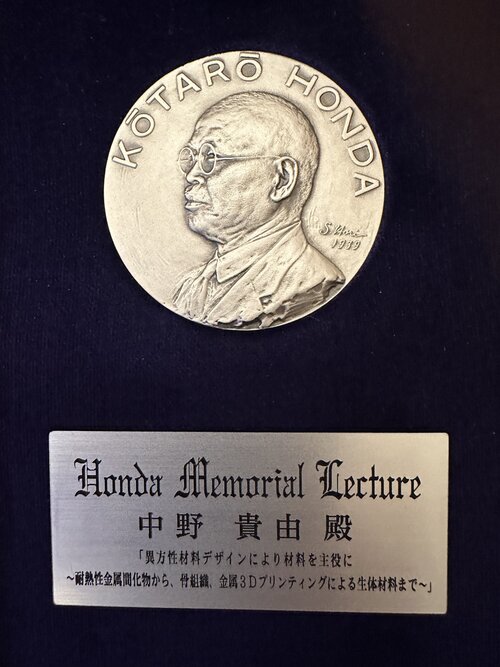
-
2025.3.6
【論文】AM触媒に関する論文が、Nature Communicationsに受理されました。
-
2025.3.4
【学会】中野研究室のメンバーが日本金属学会2025年(第176回)春期講演大会(@東京都立大学、3月8日~3月10日)に参加します。
本多記念講演
〇中野貴由:
[K1.7] [基調講演]異方性材料デザインにより材料を主役に
~耐熱性金属間化合物から、骨組織、金属3Dプリンティングによる生体材料まで~
〇小笹良輔、中野貴由:
[K2.8] [基調講演] 高強度低弾性の実現に向けたバイオハイエントロピー合金の開発
3月8日
〇菊川泰地、石本卓也、眞山剛、小笹良輔、中野貴由:
[P44] PBF-LB/M を利用した人工界面の形成と高強度化の機序解明
〇磯谷太一、松垣あいら、中野貴由:
[P117] 骨粗鬆症による骨基質配向性への影響
〇大川翔、小笹良輔、萩原幸司、松本敏治、中野貴由:
[P120] L-PBFにより造形したLPSO型Mg合金の力学特性
〇長者亮佑、奥川将行、小泉雄一郎、中野貴由:
[P125] 付加製造用電子ビーム照射で形成される共晶セラミックスの急冷凝固組織
3月9日
〇松垣あいら、中野貴由:
302 骨―免疫相互作用に基づく骨材料機能制御機構
〇齊藤光郁、松垣あいら、中野貴由:
303 薬剤投与による骨タンパク質活性化に基づく骨基質配向化制御機構
〇松坂匡晃、松垣あいら、中野貴由:
304 ひずみ速度に応じた流体加速度感受に基づく骨微細構造制御機構の解明
〇森陶子、松垣あいら、中野貴由:
306 チタン細線により配列制御した骨芽細胞の抗菌特性発現
〇元山誓織、奥川将行、小泉雄一郎、中野貴由:
169 Al-Si 合金の粉末床溶融結合での溶融・凝固条件の数値熱流体力学解析
3月10日
〇佐藤和久、高木空、市川聡、石本卓也、中野貴由:
106 SUS316L鋼LPBF材の微細組織と溶質偏析に及ぼすレーザ走査速度の影響
〇奥川将行、瀬戸口博俊、小泉雄一郎、中野貴由:
288 粉末床溶融結合Al-Si共晶合金材の階層的組織を活用した多階層性ポーラスSiの作製
〇柳玉恒、佐藤翼、奥川将行、佐藤和久、安田弘行、中野貴由、小泉雄一郎:
289 レーザー粉末床溶融結合法によって作製したFe3Al単結晶様材の力学特性
〇孫飛、足立吉隆、佐藤和久、石本卓也、中野貴由、小泉雄一郎:
291 Discovery of nano-scaled promising strengthening factor in 316L stainless steel fabricated by laser powder bed fusion
〇熊谷祥希、小柳禎彦、小笹良輔、中野貴由:
292 金属粉末レーザ積層造形法における熱間ダイス鋼の積層造形性に及ぼす雰囲気ガスの影響
〇當代光陽、髙橋凪、田中大介、永瀬丈嗣、松垣あいら、中野貴由:
318 hcp型TiZrHfAlx Bio MEAの合金設計と開発
〇星野壮希、石本卓也、Gokcekaya Ozkan、多根正和、眞山剛、中野貴由:
326 PBF-LB/Mを用いた形状・結晶集合組織制御によるIN718の力学機能設計
〇宮澤啓太郎、小笹良輔、菊川泰地、石本卓也、中野貴由:
327 L-PBF 法で作製したNi基超合金の低サイクル疲労挙動 -
2025.2.28
【新聞】JST-Crestの成果として、機械学習に基づき単結晶の弾性率を高精度で解析することに成功したことが日刊工業新聞に掲載されました。 多根先生との共同研究の成果です。
弾性率 ミクロレベル解析
日刊工業新聞 2025年2月28日 朝刊 31面
URLはこちらから→https://www.nikkan.co.jp/articles/view/00741443 -
2025.2.27
【プレスリリース】JSTと大阪大学は、中野JST-CRESTの成果として、"インプラント設計に不可欠な力学物性の解析"に関する研究成果を共同でプレスリリースしました。
金属3Dプリンティングによる高機能な生体用インプラント材開発を加速
3DP造形物設計のためのキーパラメータの高精度解析を可能に
―弾性場の逆解析モデル構築で実現―
PDFはこちら→
http://www.mat.eng.osaka-u.ac.jp/msp6/nakano/93d1319b2c81bfdcaa7b93ff1ea2ec58338bb451.pdf
JSTプレスリリースはこちら→
https://www.jst.go.jp/pr/announce/20250227-2/index.html
日本経済新聞電子版はこちらから→
https://www.nikkei.com/article/DGXZRSP687549_X20C25A2000000/ -
2025.2.22
【論文】Additive Manufacturing誌(IF=10.3)にTi合金のヤング率予測に関する論文が受理され、OA論文として掲載される予定です。
Shota Higashino, Daisuke Miyashita , Takuya Ishimoto, Eisuke Miyoshi, Takayoshi Nakano, Masakazu Tane*:
Low Young's modulus in laser powder bed fusion processed Ti-15Mo-5Zr-3Al alloys achieved by the control of crystallographic texture combined with the retention of low-stability bcc structure, Additive Manufacturing, accepted, (2025). -
2025.2.22
【記事】中野研が取り上げられたJSTニュースの1月号が中国語で翻訳され、掲載されました。
・日本語サイト
JSTニュース1月号
https://www.jst.go.jp/pr/jst-news/backnumber/2024/202501/index.html
・簡体字サイト
> 科学研究 > 机械/机器人 > 【特集】利用金属3D打印机开发椎间融合器,提升骨骼强度,精密制作微细结构(上)
https://www.keguanjp.com/kgjp_keji/kgjp_kj_robot/pt20250218000013.html
> 科学研究 > 机械/机器人 > 【特集】利用金属3D打印机开发椎间融合器,提升骨骼强度,精密制作微细结构(下)
https://www.keguanjp.com/kgjp_keji/kgjp_kj_robot/pt20250219000014.html
・繁体字サイト
> 科學研究 > 機械/機器人 > 【特集】利用金屬3D列印機開發椎間融合器,提升骨骼強度,精密製作細結構(上)
https://tc.keguanjp.com/kgjp_keji/kgjp_kj_robot/pt20250218000013.html
> 科學研究 > 機械/機器人 > 【特集】利用金屬3D列印機開發椎間融合器,提升骨骼強度,精密製作細結構(下)
https://tc.keguanjp.com/kgjp_keji/kgjp_kj_robot/pt20250219000014.html -
2025.2.20
【行事】毎年恒例の中野研の追いコンが開催されました。
-
2025.2.19
【卒論】卒業論文発表会が行われました。
-
2025.2.18
【HP】ヒット数が40万件を突破!
中野研HPのヒット数が40万件を突破しました。
いつもご覧いただき、ありがとうございます。 -
2025.2.18
【受賞】帝人ナカシマメディカルと中野研で共同開発したUNIOS PLスペーサーが大河内記念技術賞を受賞します。授賞式は、2025年3月25日です。
大河内記念技術賞:高強度配向骨の誘導による積層造形整形外科デバイスの付加価値向上と製品化
高橋 広幸 帝人ナカシマメディカル株式会社 研究部 副部長 博士(工学)
中島 義雄 帝人ナカシマメディカル株式会社 取締役会長
加藤 直之 帝人ナカシマメディカル株式会社 代表取締役社長
小林 貴史 帝人ナカシマメディカル株式会社 代表取締役副社長
中野 貴由 大阪大学 大学院工学研究科 栄誉教授 博士(工学) -
2025.2.13
【修論】修士論文発表会が行われました。
-
2025.2.12
【卒論】卒業論文を皆完成させ提出しました。
-
2025.2.10
【新聞】大阪大学が3Dプリンターをブランド化しようと考えている記事が読売新聞朝刊に掲載されました。阪大工AMセンターも、貢献できるように頑張りたいと思います。4月発足の日本AM学会も紹介されています。
3Dプリンター 阪大から世界へ、読売新聞、2025年2月9日、朝刊19面(関西版)
記事はこちらから→
https://www.yomiuri.co.jp/local/kansai/feature/CO049294/20250206-OYTAT50028/ -
2025.2.7
【論文】レーザー・電子ビーム積層造形時の後処理の微細構造の影響に関する論文がCIRP Journal of Manufacturing Science and Technology(IF=4.6)に掲載されました。
Jibin Boban*, Afzaal Ahmed, Ozkan Gokcekaya , Takayoshi Nakano:
Ultra-precision surface treatment of beta-Titanium alloy printed using laser and electron beam melting sources,
CIRP Journal of Manufacturing Science and Technology, 58, (2025), 01.006; 1-19.
https://doi.org/10.1016/j.cirpj.2025.01.006
論文はこちら
PDFはこちら
Abstract
Additive Manufacturing (AM) is a near net shape fabrication technology offering exceptional design freedom for complex part production. However, the inadequate surface quality and poorly generated micro-features adversely affect the functional performance of metal AM parts thereby restricting the direct adoption in biomedical implantation applications. Ultra-precision diamond turning (UPDT) can be regarded as a possible solution to overcome the aforementioned challenges in metal AM. However, the machinability of metal AM parts at ultra-precision level is highly sensitive to the material specific attributes and microstructure generated by the thermal characteristics of the process. In light of this, the present study follows a novel direction by investigating the dependence of distinct material characteristics imparted by two different AM powder melting sources on the ultra-precision post-treatment performance. Experiments were conducted on laser and electron beam printed beta-Ti alloy (Ti-15Mo-5Zr-3Al) which has potential importance in biomedical applications. The results demonstrate that the microstructural variations in respective samples affect the process performance and final surface integrity. The samples printed using laser powder bed fusion (LPBF) achieved a final surface finish (Sa) of ~66.3 nm after UPDT relative to the electron beam powder bed fusion (EPBF) samples (~104.3 nm). The cutting forces tends to exhibit sharp dip in forces in case of LPBF samples when micro-cutting was done perpendicular to the beam scanning direction. The chip morphology analysis corresponding to the LPBF and EPBF samples sub stantiates the generation of chips with segmentation/serrations on the free chip surface and parent material adhesion on the tool-chip contact surface. Further, precise microfeature generation was successfully accom plished on both the samples with minimal dimensional deviations on LPBF sample. Thus, the outcomes of the study establish the potential of UPDT in elevating the bioimplant surface standards of beta-Ti alloy with superior performance in LPBF samples.Keywords
Additive manufacturing; Powder bed fusion; Diamond turning; Titanium; Microstructure -
2025.2.4
【修論】修士論文を皆完成させ提出しました。
-
2025.1.26
【新聞】鉄鋼新聞に中野研に関する記事が掲載されました。
阪大とJST/金属3Dプリンティング/結晶配向性の制御法確立/低強度から高強度まで単一材で力学機能設計可能に:鉄鋼新聞 電子版、2025年1月26日
URLはこちらから→https://www.nikkinonline.com/premium/trendslist/245286 -
2025.1.22
【記事】「ShareLab」にて、中野 貴由 教授、石本 卓也 特任教授をはじめとする研究グループが、金属3Dプリンターによって結晶配向方位の制御に成功したことが、記事として掲載されました。
世界初!大阪大学研究チームが金属3Dプリンティングで3種の結晶配向(原子配列方向)を実現
URLはこちらから→https://news.sharelab.jp/cases/medical/jst-osaka-u-250122/ -
2025.1.17
【論文】レーザー・電子ビーム積層造形時の後処理の微細構造の影響に関する論文がCIRP Journal of Manufacturing Science and Technology(IF=4.6)に受理されました。
Jibin Boban*, Afzaal Ahmed, Ozkan Gokcekaya , Takayoshi Nakano:
Ultra-precision surface treatment of beta-Titanium alloy printed using laser and electron beam melting sources,
CIRP Journal of Manufacturing Science and Technology, (2025), in press. -
2025.1.15
【論文】メチルグリオキサールが骨芽細胞分化を通じて骨折治療を阻害することを解明した山口大学医学部との共同研究がBiochemical and Biophysical Research Communications誌に掲載されました。
Tetsuya Seto, Kiminori Yukata, Shunya Tsuji*, Yusuke Takeshima, Takeshi Honda, Akihiko Sakamoto, Kenji Takemoto, Hiroki Sakai, Mayu Matsuo, Yurika Sasaki, Mizuki Kaneda, Mikako Yoshimura, Atsushi Mihara, Kazuya Uehara, Aira Matsugaki, Takayoshi Nakano, Koji Harada, Yoshiro Tahara, Keiko Iwaisako, Ryoji Yanai, Norihiko Takeda, Takashi Sakai, Masataka Asagiri*:
Methylglyoxal compromises callus mineralization and impairs fracture healing through suppression of osteoblast terminal differentiation,
Biochemical and Biophysical Research Communications, 747, (2025), 151312; 1-8.
https://doi.org/10.1016/j.bbrc.2025.151312
論文はこちら
PDFはこちら
Abstract
Impaired fracture healing in diabetic patients leads to prolonged morbidity and increased healthcare costs. Methylglyoxal (MG), a reactive metabolite elevated in diabetes, is implicated in various complications, but its direct impact on bone healing remains unclear. Here, using a non-diabetic murine tibial fracture model, we demonstrate that MG directly impairs fracture healing. Micro-computed tomography revealed decreased volumetric bone mineral density in the callus, while callus volume remained unchanged, resulting in a brittle bone structure. This was accompanied by reduced expression of osteocalcin and bone sialoprotein, both critical for mineralization. Biomechanical analysis indicated that MG reduced the mechanical resilience of the fracture site without altering its elastic strength, suggesting that the impairment was not primarily due to the accumulation of advanced glycation end-products in the bone extracellular matrix. In vitro studies confirmed that non-cytotoxic concentrations of MG inhibited osteoblast maturation and mineralization. Transcriptomic analysis identified downregulation of Osterix, a key transcription factor for osteoblast maturation, without altering Runx2 levels, leading to decreased expression of key mineralization-related factors like osteocalcin. These findings align with clinical observations of reduced circulating osteocalcin levels in diabetic patients, suggesting that the detrimental effects of MG on osteoblasts may extend beyond bone metabolism. Our study highlights MG and MG-sensitive pathways as potential therapeutic targets for improving bone repair in individuals with diabetes and other conditions characterized by elevated MG levels.Keywords
Fracture healing; Osteoblasts; Diabetes; Methylglyoxal -
2025.1.14
【論文】Acta Biomaterialia(IF=9.4)にMPCポリマーでのゼブラコーティングによる骨配向化誘導に関する論文が掲載されました。
Tadaaki Matsuzaka, Aira Matsugaki*, Kazuhiko Ishihara, Takayoshi Nakano*:
Osteogenic tailoring of oriented bone matrix organization using on/off micropatterning for osteoblast adhesion on titanium surfaces, Acta Biomaterialia, 192, (2025), 39644943; 487-500.
https://doi.org/10.1016/j.actbio.2024.12.017Abstract
Titanium (Ti) implants are well known for their mechanical reliability and chemical stability, crucial for suc cessful bone regeneration. Various shape control and surface modification techniques to enhance biological activity have been developed. Despite the crucial importance of the collagen/apatite bone microstructure for mechanical function, antimicrobial properties, and biocompatibility, precise and versatile pattern control for regenerating the microstructure remains challenging. Here, we developed a novel osteogenic tailoring stripe- micropatterned MPC-Ti substrate that induces genetic-level control of oriented bone matrix organization. This biomaterial was created by micropatterning 2-methacryloyloxyethyl phosphorylcholine (MPC) polymer onto a titanium (Ti) surface through a selective photoreaction. The stripe-micropatterned MPC-Ti substrate establishes a distinct interface for cell adhesion, robustly inducing osteoblast cytoskeleton alignment through actin cyto skeletal alignment, and facilitating the formation of a bone-mimicking-oriented collagen/apatite tissue. More over, our study revealed that this bone alignment process is promoted through the activation of the Wnt/ β-catenin signaling pathway, which is triggered by nuclear deformation induced by strong cellular alignment guidance. This innovative material is essential for personalized next-generation medical devices, offering high customizability and active restoration of the bone microstructure.
Keywords
Photoreactive; MPC polymer; Stripe-micropatterned titanium substrate; Osteoblast orientation; Apatite/collagen orientation; Bone regeneration -
2025.1.11
【会議】JST-Crestナノ力学の中野チームの研究会を阿蘇で開催しました。活発で有意義な議論ができました。ご準備いただいた眞山教授に御礼申し上げます。
-
2025.1.9
【新聞】日刊工業新聞朝刊に「阪大、金属の結晶配向性制御 力学機能設計可能に」が掲載されました。
金属の結晶配向性制御 阪大、力学機能設計可能に3Dプリンター利用
日刊工業新聞、2025年1月9日朝刊、科学技術・大学(23面) -
2025.1.9
【論文】メチルグリオキサールが骨芽細胞分化を通じて骨折治療を阻害することを解明した山口大学医学部との共同研究がBiochemical and Biophysical Research Communications誌に受理されました。
Tetsuya Seto, Kiminori Yukata, Shunya Tsuji*, Yusuke Takeshima, Takeshi Honda, Akihiko Sakamoto, Kenji Takemoto, Hiroki Sakai, Mayu Matsuo, Yurika Sasaki, Mizuki Kaneda, Mikako Yoshimura, Atsushi Mihara, Kazuya Uehara, Aira Matsugaki, Takayoshi Nakano, Koji Harada, Yoshiro Tahara, Keiko Iwaisako, Ryoji Yanai, Norihiko Takeda, Takashi Sakai, Masataka Asagiri*: Methylglyoxal compromises callus mineralization and impairs fracture healing through suppression of osteoblast terminal differentiation, Biochemical and Biophysical Research Communications, (2025), in press. -
2025.1.8
【論文】Acta Materialia誌(Elsevier, IF=8.3)に、JST-Crestの成果である、"AMによる「材質(結晶配向性)」と「形状」の重畳による力学機能発現"に関する論文が受理されました。AMの世界を大きく変える研究結果で、OA論文として掲載されました。
Takuya Ishimoto, Naotaka Morita, Ryosuke Ozasa, Aira Matsugaki, Ozkan Gokcekaya, Shota Higashino, Masakazu Tane, Tsuyoshi Mayama, Ken Cho, Hiroyuki Y. Yasuda, Masayuki Okugawa, Yuichiro Koizumi, Masato Yoshiya, Daisuke Egusa, Taisuke Sasaki, Eiji Abe, Hajime Kimizuka, Naoko Ikeo, Takayoshi Nakano*:
Superimpositional design of crystallographic textures and macroscopic shapes via metal additive manufacturing--Game-change in component design, Acta Materialia, 286, (2025), 120709; 1-12.
DOI: https://doi.org/10.1016/j.actamat.2025.120709
論文はこちら
PDFはこちら
Abstract
This study demonstrates the control of the crystalline orientation through metal additive manufacturing, enabling the development of component design guidelines that incorporate the inherent anisotropy of the me chanical properties (e.g., Young's modulus) in crystalline materials. We, for the first time, successfully fabricated a <111>//build direction (BD)-oriented single-crystalline-like texture in an alloy with a cubic crystal structure via laser powder bed fusion (LPBF) and completed a series of three single-crystalline-like microstructures with <001>, <011>, and <111>//BD orientations in a single material. The <001>and <111>directions exhibited the lowest and highest Young's moduli, respectively, demonstrating a wide range of control over the anisotropy of the mechanical properties of the product. To achieve a <111>//BD-oriented single-crystalline-like texture, a novel three-layer cyclic strategy of "uni"directional laser scanning at 120◦ angular intervals was developed by considering the easy growth direction and crystal symmetry. To the best of our knowledge, no previous study has reported this unique strategy. By superimposing the realized <111>orientation and shape-based anisotropy, products exhibiting high Young's modulus anisotropy, which cannot be expressed by shape and texture alone, were obtained via the LPBF single process. This achievement holds promise for the realization of a new component design guideline that integrates texture (mechanical properties) design for each internal location--modifiable through scanning strategies--with traditional shape optimization techniques typically used in computer-aided design. This approach enables tailored mechanical performance through optimized design strategies.Keywords
Laser powder bed fusion; Shape anisotropy; Crystallographic orientation; Superimposition; 3D puzzle; Young's modulus -
2025.1.8
【新聞】日本経済新聞電子版に当研究室から出版されたActa Materialia論文が「阪大、金属3Dプリンティングで3種の結晶配向(原子配列方向)を実現」として紹介されました。
-
2025.1.8
【プレスリリース】JSTと大阪大学は、中野JST-CRESTの成果として、"AMによる「材質(結晶配向性)」と「形状」の重畳による力学機能発現"に関する研究成果を共同でプレスリリースしました。同時にActa Materialia誌(Elsevier, IF=8.3, Top3%ジャーナル)に掲載されました。
-
2025.1.6
【解説】JSTニュース1月号に、中野先生と中島帝人ナカシマ会長が取材を受けたUNIOS PLスペーサーの記事が掲載されました。
中野貴由、中島義雄:
金属3Dプリンターで椎間スペーサー開発骨の強度を高め、微細構造を精緻に作製、
JSTnews (ISSN 1349-6085)、(2025)、8-11.
JSTニュースはこちらから→
https://www.jst.go.jp/pr/jst-news/
1月号はこちらから→
chrome-extension://efaidnbmnnnibpcajpcglclefindmkaj/https://www.jst.go.jp/pr/jst-news/backnumber/2024/202501/pdf/2025_01.pdf
本件記事のみのPDFはこちらから→
chrome-extension://efaidnbmnnnibpcajpcglclefindmkaj/https://www.jst.go.jp/pr/jst-news/backnumber/2024/202501/pdf/2025_01_p8-11.pdf
抜粋版はこちらから→
http://www.mat.eng.osaka-u.ac.jp/msp6/nakano/883dad95bf70bb2a22e8a8749706efc4f60658a6.pdf -
2025.1.1
【論文】Acta Materialia誌(Elsevier, IF=8.3)に、JST-Crestの成果である、"AMによる「材質(結晶配向性)」と「形状」の重畳による力学機能発現"に関する論文が受理されました。AMの世界を大きく変える研究結果で、OA論文として出版される予定です。
Takuya Ishimoto, Naotaka Morita, Ryosuke Ozasa, Aira Matsugaki, Ozkan Gokcekaya, Shota Higashino, Masakazu Tane, Tsuyoshi Mayama, Ken Cho, Hiroyuki Y. Yasuda, Masayuki Okugawa, Yuichiro Koizumi, Masato Yoshiya, Daisuke Egusa, Taisuke Sasaki, Eiji Abe, Hajime Kimizuka, Naoko Ikeo, Takayoshi Nakano*:
Superimpositional design of crystallographic textures and macroscopic shapes via metal additive manufacturing--Game-change in component design, Acta Materialia, (2025), in press. -
2025.1.1
新年あけましておめでとうございます。旧年中は皆様からのご指導をいただきありがとうございました。今年も中野研究室一同一丸となって教育・研究に邁進する所存でございます。引き続きご指導のほどよろしくお願い申し上げます。














